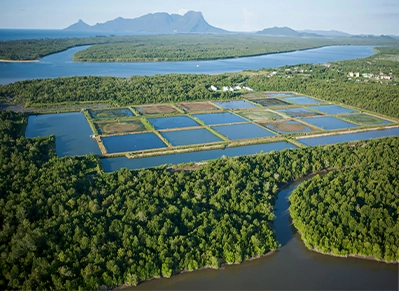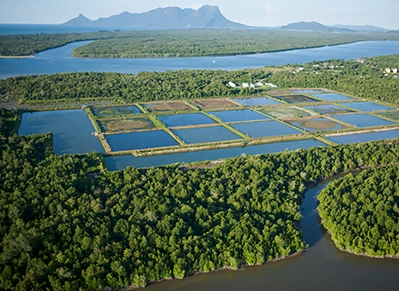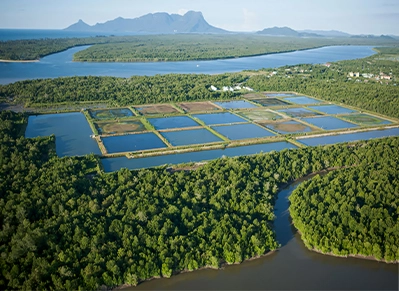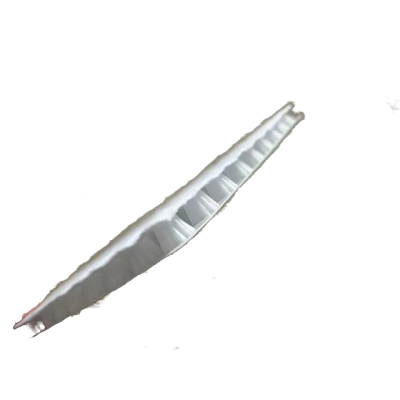Introduction
Drainage Nets for Driveaway is a sheet product made of geosynthetics, mainly designed to acquire and direct the glide of liquid (usually water) whilst stopping soil particles from getting into and blocking off the drainage channel. It normally consists of a third-dimensional mesh core and a filter layer. "Drainage Net" for driveway is a geosynthetic drainage fabric (geosynthetic drainage composite net) laid in the driveway shape layer (usually on the pinnacle of the roadbed soil or in the gravel base). Its core feature is to actively accumulate and rapidly drain the water that penetrates into the driveway, forestall the roadbed softening, frost heave damage, bearing ability discount and street floor injury brought on through water accumulation, thereby notably enhancing the stability, sturdiness and carrier existence of the driveway. It is a preventive and performance-enhancing key engineering material.
Function
1. Water conduction: The three-d shape of the mesh core presents excessive water conductivity, which can rapidly and efficiently drain water (such as groundwater, rainwater, seepage water) alongside its aircraft direction.
2. Filtration: The geotextile layer prevents soil from invading the drainage channel and keeps the long-term effectiveness of the drainage system.
3. Separation: Sometimes it additionally serves to separate unique soil layers.
4. Protection: Protect the extra fragile water-resistant layer beneath (such as geomembrane) from strain puncture of the overlying soil and rock and the buoyancy of groundwater.
5. Reinforcement: In some applications, it can grant a positive reinforcement effect.
Specific Function & Working Principle
1. Collect and divert moisture:
Rainwater, snowmelt or groundwater will penetrate into the driveway shape (under asphalt, concrete, paving bricks).
The third-dimensional core shape of the drainage community affords an environment friendly in-plane water channel.
It can rapidly accumulate this infiltrated water and divert it horizontally to the drainage ditch, water series properly or herbal drainage vicinity at the aspect of the lane to forestall water from amassing inner the lane structure.
2. Prevent water damage:
Reduce freeze-thaw harm (Frost Heave): In bloodless areas, water collected in the roadbed freezes and expands (frost heave), inflicting the roadbed to soften and decrease its bearing capability when it melts in spring. Repeated freeze-thaw will critically injury the floor of the lane (cracks, unevenness). The drainage net correctly drains away water, notably lowering the threat of frost heave.
3. Preventing softening of the base/roadbed: Long-term immersion will soften and lose power of soil and base substances (such as overwhelmed stone), and without problems motive rutting, agreement and cracks underneath car load. The drainage internet continues the base fantastically dry and keeps its bearing capacity.
4. Extending carrier life: By decreasing water damage, the provider lifestyles of the lane pavement is extensively extended, lowering the frequency and value of maintenance.
5. Filtration and separation:
The geotextile (non-woven fabric) filter layer on the floor of the drainage internet permits water to ignore freely, however prevents high-quality soil particles from getting into and blocking off the drainage channels internal the mesh core, making sure long-term drainage efficiency.
It can additionally separate exclusive layers of soil or combination (such as roadbed soil and beaten stone base) to a sure extent, forestall them from mixing with every other, and hold the integrity of the structural layer.
Application
1. Waterproof drainage structures round constructing basis partitions and basements (such as blind ditches, drainage layers at the back of water-proof boards).
2. Drainage at the back of tunnel and subway lining.
3. Drainage interior roadbed, shoulders, conserving walls, and slopes.
4. Leachate series and drainage layer for landfills and tailings ponds.
5. Drainage layer for roof gardens and inexperienced walls.
6. Underground drainage for sports activities venues (such as soccer fields and golf courses).
Agricultural drainage.
Typical Utility Areas (In Driveway Structures)
1. Top of subgrade: Laid on compacted subgrade soil, and then a overwhelmed stone base route is laid on it. This is the most frequent region and is used to intercept water from beneath (capillary upward jab of groundwater or lateral infiltration) and above (water infiltrating the base course).
2. Inside or backside of the base course: Sometimes laid interior or underneath the beaten stone layer to greater successfully accumulate water in that layer.
3. Under permeable paving: If the driveway makes use of permeable paving (such as permeable concrete, permeable asphalt, permeable paving bricks), the drainage mesh will be laid underneath the permeable base direction or as phase of it to speed up the series and drainage of infiltrated rainwater.
Why Is It Necessary to Use Drainage Mesh on Driveways?
1. Driveways are load-bearing constructions and require a robust and steady foundation. Water is one of the primary destabilizing factors.
2. Traditional driveway buildings (such as gravel and asphalt laid at once on compacted soil) have constrained drainage capabilities, in particular in areas with excessive groundwater levels, negative soil permeability (such as clay), or excessive rainfall.
3. Installing drainage mesh is a cost-effective, pretty easy answer that can appreciably enhance the sturdiness and overall performance of driveways.
Technical Parameters
I. Hydraulic Properties
This is the core performance index of the drainage network, which directly determines its drainage efficiency.
1. In-Plane Transmissivity (θ):
Definition: The water flow rate that a drainage network of unit width can transmit under normal pressure under unit gradient (unit: m²/s or L/min·m). The larger the value, the stronger the drainage capacity.
Key influencing factors: Normal pressure, hydraulic gradient, long-term performance (considering clogging and creep).
Test standard: ASTM D4716 / ISO 12958. It is necessary to pay attention to the test values under specific normal pressure (such as 100 kPa, 200 kPa, 500 kPa) and specific hydraulic gradient (such as 0.1).
Lane application requirements: The minimum required hydraulic conductivity needs to be determined based on the expected seepage volume, drainage path length and design safety factor. It is usually required to have good water conductivity under medium and high pressure (such as 200-500 kPa).
2. Geonet Planar Permeability (kp):
Definition: Only for geonet, it indicates the ability of the material itself to conduct water in the plane direction (unit: m/s). Water conductivity (θ) = kp * thickness. Commonly used when comparing pure geonet performance.
Test standard: ASTM D4491 (Modified) / EN ISO 11058.
II. Mechanical Properties
Ensure that the drainage network can withstand loads without failure during construction and use.
1. Compressive Strength (CBR Strength)
Definition: The ability of a material to resist normal (vertical) pressure. It is usually expressed in CBR Puncture Strength (unit: kN/m or N). Extremely important for driveway applications! Need to withstand the impact of aggregate intrusion, paving equipment and vehicle loads.
Test Standard: ASTM D6241 / ISO 12236. Report the pressure value or peak pressure at a specific displacement (such as 5% or 10%).
Driveway Application Requirements: Usually require high CBR strength (much higher than products used for landfill covers or wall drainage), the specific value depends on the design load and the base material, and the common range is several thousand Newtons per meter (kN/m).
2. Compressive Creep
Definition: The phenomenon of material thickness decreasing over time under long-term constant pressure. Excessive creep will significantly reduce hydraulic conductivity.
Test Standard: ASTM D7361 / GRI GC8. Report the compression set rate or residual thickness after a specific time (such as 1000 hours, 10,000 hours) at a specific pressure.
Driveway Application Requirements: Require low creep performance to ensure that the drainage channel space is not significantly reduced under long-term use.
3. Tensile Strength and Elongation
Definition: The ability of a material to resist longitudinal tensile fracture (unit: kN/m) and the percentage of elongation at fracture. Mainly affects the tensile resistance during construction.
Test standard: ASTM D4595 (geotextile) / ASTM D6637 (Geonet/Geocomposite). Divided into longitudinal (MD) and transverse (XD).
Lane application requirements: Must meet construction paving requirements, generally moderate requirements.
4. Interface friction angle (Interface Shear Strength / Friction Angle)
Definition: The friction characteristics between the drainage network and the upper and lower contact materials (such as geotextile, soil, aggregate) (unit: angle ° or cohesion kPa). Affects slope stability.
Test standard: ASTM D5321 / ASTM D6243 (geotextile).
Lane application requirements: This is particularly important in slope lane or shoulder applications to ensure that no sliding instability occurs.
III. Physical Properties
1. Thickness
Definition: The thickness of the product measured under a specific normal pressure (e.g. 2 kPa, 20 kPa, 200 kPa) (unit: mm). The thickness under pressure directly affects the water conduction space.
Test standard: ASTM D5199 / ISO 9863-1.
Lane application requirements: Focus on the thickness under the design working pressure, not the zero pressure thickness.
2. Mass per Unit Area
Definition: The unit area weight of the geotextile filter layer or the entire composite drainage network (unit: g/m²). Indirectly reflects the material usage and strength potential.
Test standard: ASTM D5261 / EN 965.
Lane application requirements: The geotextile filter layer must be heavy enough to ensure its filtration and anti-clogging performance.
3. Opening Size / Apparent Opening Size (O₉₀ / AOS)
Definition: For geotextile filter only, it indicates its ability to block particles. O₉₀ means 90% of the particles are smaller than this size (unit: mm or US Sieve No.). AOS is similar. Key filtration parameter.
Test standard: ASTM D4751 (dry sieving method) / ISO 12956 (wet sieving method is more recommended).
Driveway application requirements: Must be carefully selected according to the particle size distribution of the protected soil (especially the fine particle content) and follow the filtration criteria (soil retention, water permeability, anti-clogging). Improper selection will lead to drainage failure.
4. Permittivity (Ψ)
Definition: For geotextile filter only, it indicates its water permeability under normal water flow conditions (unit: s⁻¹). The larger the value, the easier it is for water to pass vertically through the geotextile into the drainage mesh core.
Test Standard: ASTM D4491.
Lane Application Requirements: Need to be high enough to ensure that water can flow smoothly into the drainage mesh core.
IV. Endurance Properties
Evaluate the material's ability to maintain performance in a long-term use environment.
1. UV Resistance
Definition: The material's strength retention rate after exposure to ultraviolet light. Usually evaluated by accelerated aging tests.
Test Standard: ASTM D4355 / ISO 4892. Report the percentage of tensile strength retained after a certain exposure time (such as 500 hours).
Lane Application Requirements: For products that may be exposed for a short period of time after paving (such as during construction), a certain UV stability is required. Long-term burial is not a primary consideration.
2. Chemical/Biological Resistance
Definition: HDPE mesh cores generally have excellent resistance to acid, alkali, and microbial degradation. Geotextiles (polyester or polypropylene) also need to be evaluated for their chemical resistance.
Basis: The chemical inertness of the material itself. Refer to relevant standards or chemical resistance data provided by suppliers.
Lane application requirements: General soil environments pose little threat to HDPE and common geotextiles, and special contaminated sites require additional assessment.
3. Long-Term Design Strength / Creep Reduction Factors
Definition: The strength value (such as tensile strength, CBR strength) at which the material can be safely used after considering the long-term creep effect. It needs to be derived from long-term creep test data.
Basis: Based on guidelines such as GRI GC8 or long-term performance data provided by suppliers.
Lane application requirements: Critical! Long-term design strength must be used when designing, not short-term test values.
V. Material Specifications
1. Core Material: Usually high-density polyethylene (HDPE). Pay attention to resin grade, additives (such as carbon black for UV resistance), density, melt index (MI), etc.
2. Filter Material: Usually polyester (PET) or polypropylene (PP) needle-punched non-woven geotextile. Pay attention to the fiber type, production process, and whether it contains additives (such as anti-aging agents).
3. Bonding Method: Thermal Bonding or Needle-Punched. Affects composite strength, water conductivity and anti-clogging.
VI. Summary of key points for lane application selection
1. Water conductivity is the core: Ensure that the design drainage flow requirements can still be met under the design load pressure.
2. Compressive strength is the foundation: It must be able to withstand construction loads and vehicle loads to avoid excessive compression that causes a sudden drop in water conductivity. CBR strength is the top priority.
3. Filtration design is a guarantee: Geotextile O₉₀/AOS must be strictly selected according to the particle grading of the roadbed soil and meet the permeability (Ψ) to prevent clogging.
4. Long-term performance is key: The effect of creep on thickness and conductivity must be considered and the design should be based on long-term design parameters.
Standard testing is the basis: All parameters must be obtained under standard test methods (such as ASTM, ISO, GRI) to make the data comparable and reliable.
Key Properties Required
1. High hydraulic conductivity: Quickly conducts water away.
2. High compressive energy (CBR): Withstands the stress of the top gravel base, paving layer, and car masses besides being overly compressed (excessive compression reduces the water conduction space). Drainage mesh used in driveways normally requires excessive compressive strength.
3. Excellent filtration performance: Geotextiles want to in shape the surrounding soil to forestall clogging.
Durability: Resist development injury and long-term chemical/biological environments.
ABout Us
Since 2008, Haoyang Environmental Technology ( Shandong ) Co., Ltd. manufactures high-strength HDPE Geonet systems as China's premier 3D Drainage Geocomposite specialist, our patented Composite Drainage Net features diamond-grid cores delivering 5100 m²/day in-plane flow capacity under 500 kPa compression—ideal for highways, port access roads, and heavy-load driveways where rapid subsurface water dissipation prevents frost heave and base saturation. Utilizing virgin HDPE Geonet Drainage materials with UV stabilization, these 3D Drainage Networks replace traditional gravel layers while providing 25 kN/m tensile strength for ground stabilization. Available as modular Drain Netting rolls for seamless installation, our Net for Drainage solutions are field-proven in Canadian permafrost logistics hubs and Southeast Asian monsoon ports. Request technical specs for Geonet Drainage systems tailored to 20-ton axle loads.








